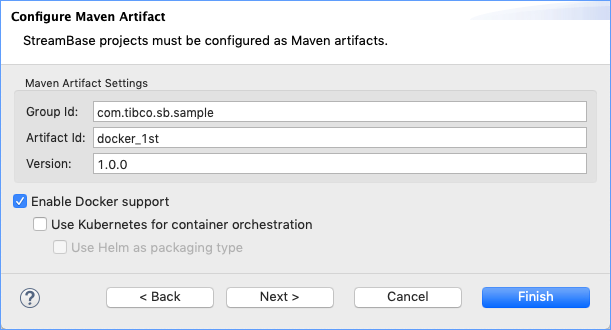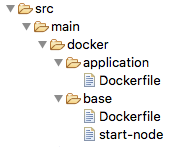You enable Docker support for a new StreamBase project by means of the check box on the Configure Maven Artifact panel.
 |
Docker-enabled StreamBase Application projects have the following additional features, compared to non-Docker projects.
- src/main/docker
-
Studio places the Dockerfiles and a run script that are used to create Docker images in
src/main/docker:
You can edit these files before creating your Docker image to specify different defaults. See the comments in the files for the variables you can change.
For example, consider this passage at the top of
src/main/docker/base/Dockerfile. To specify a different administration username for the node in the Docker container, you can changetibcoto another name.# # Set environment # ENV STREAMING_PRODUCT_HOME /opt/tibco/streambase ENV STREAMING_RUNTIME_HOME /var/opt/tibco/streambase ENV JAVA_HOME /etc/alternatives/jre ENV PATH /bin:/usr/sbin:${STREAMING_PRODUCT_HOME}/distrib/tibco/bin ENV USER_NAME tibco - src/main/configurations
-
Docker–enabled projects have three HOCON configuration files created with default settings to configure containerized StreamBase nodes:
app.conf defaultmode.conf security.conf The domain name value of the
hostsproperty insecurity.confis taken from the dockerDomain property that you specify when creating the project. The default isexample.com.// Default host-based security // name = "docker_1st" version = "1.0.0" type = "com.tibco.ep.dtm.configuration.security" configuration = { // Make all nodes trusted in the docker network to // eliminate the need for any credentials when accessing // remote nodes // TrustedHosts = { hosts = [ "*.example.com" ] } } - Modifying Docker Base Images
-
You can modify the
Dockerfileto select a different operating system base image. New projects currently default toalmalinux. For a list of supported operating systems, refer Operating Systems. Ensure that the chosen base image includes all Streaming prerequisites or that your update manager is correctly configured to allow the installation of those prerequisites.For example, the Red Hat Enterprise Linux Server 9
FROM redhat/ubi9:latestbase image does not include all the Streaming prerequisites. An active Red Hat subscription is required to perform thednfsystem updates. To enable these updates, modify theDockerfileto activate your subscription before performing the updates. This can be done by adding the following command:# Subscribe to enable dnf repos RUN subscription-manager register --username='<RHEL_USER>' --password='<RHEL_PW>'
To create and run more than one Docker containerized StreamBase node that can all communicate with each other without user authentication, you must configure both Docker network settings and StreamBase Runtime settings as follows:
-
Configure Docker network settings with
--networkand--hostnameoptions for the docker run command. -
Specify TrustedHosts membership in the same network for your StreamBase Runtime nodes.
This is done for you when you specify a
dockerDomainwhen creating the StreamBase Application project. Studio takes the domain name you provide and enters it into the TrustedHosts root object of thesecurity.confconfiguration file created for that project. -
Use the same domain name in the
--networkDocker option and in the TrustedHosts configuration.
The following example configures a three node cluster, with node each running the same docker_1st StreamBase Application.
docker network create example.com docker run -d --name nodeA -e STREAMING_NODENAME=A.cluster \ --network example.com --hostname A.example.com docker_1st:1.0.0 docker run -d --name nodeB -e STREAMING_NODENAME=B.cluster \ --network example.com --hostname B.example.com docker_1st:1.0.0 docker run -d --name nodeC -e STREAMING_NODENAME=C.cluster \ --network example.com --hostname C.example.com docker_1st:1.0.0
This example is artificial, because the three nodes contain only the firstapp EventFlow fragment with no availabilityZones HA configuration. You can add that configuration and recreate the Docker images. For further information on availabilityZones configuration, see Runtime Node Configuration in the Configuration Guide.
For further information on command line options for the docker run command, see Configure Networking in Docker's documentation.
